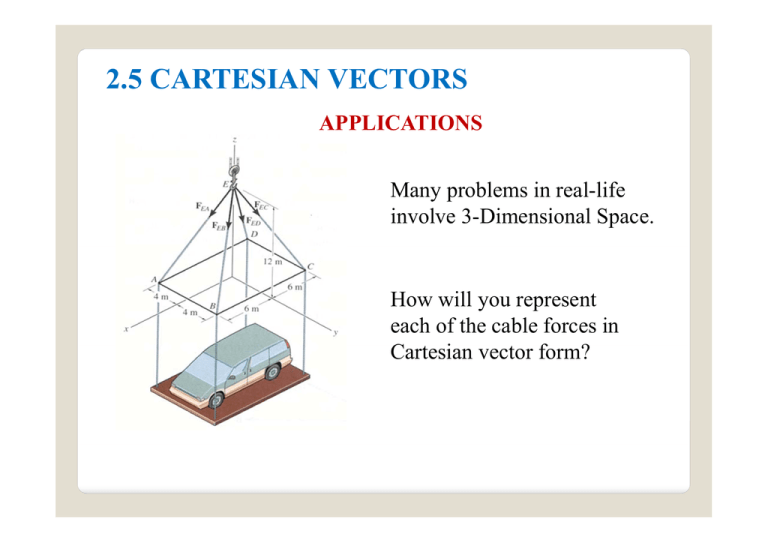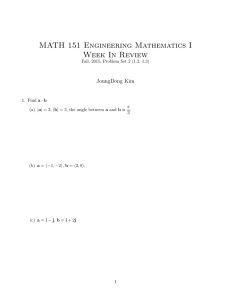Cartesian Vectors in 3D Space: Applications & Examples
advertisement

2.5 CARTESIAN VECTORS
APPLICATIONS
Many problems in real-life
involve 3-Dimensional Space.
How will you represent
each of the cable forces in
Cartesian vector form?
APPLICATIONS
(continued)
Given the forces in the cables, how will you determine
the resultant force acting at D, the top of the tower?
A UNIT VECTOR
For a vector A with a magnitude of
A, an unit vector is defined as UA =
A / A . Also, A= uA A
Characteristics of a unit vector:
a) Its magnitude is 1.
b) It is dimensionless.
c) It points in the same direction as the
original vector (A).
The unit vectors in the Cartesian axis
system are i, j, and k. They are unit
vectors along the positive x, y, and z
axes respectively.
3-D CARTESIAN VECTOR REPRESENTATION
Consider a box with sides AX,
AY, and AZ meters long.
The vector A can be defined as
A = (AX i + AY j + AZ k) m
The projection of the vector A in the x-y plane is A´. The
magnitude of this projection, A´, is found by using the same
approach as a 2-D vector: A´ = (AX2 + AY2)1/2 .
The magnitude of the position vector A can now be obtained as
A = ((A´)2 + AZ2) ½ = (AX2 + AY2 + AZ2) ½
3-D CARTESIAN VECTOR REPRESENTATION
(continued)
The direction or orientation of vector A is defined
by the angles α, β, and γ.
These angles are measured between the vector
and the positive X, Y and Z axes, respectively.
Their range of values are from 0° to 180°
Using trigonometry, “direction cosines” are found using the formulas
These angles are not independent. They must satisfy the following equation.
cos ² α + cos ² β + cos ² γ = 1
This result can be derived from the definition of a coordinate direction angles
and the unit vector. Recall, the formula for finding the unit vector of any
position vector:
or written another way, u A = cos α i + cos β j + cos γ k .
2.6 ADDITION/SUBTRACTION OF VECTORS
Once individual vectors are written in Cartesian form, it is easy
to add or subtract them. The process is essentially the same as
when 2-D vectors are added.
For example, if
A = AX i + AY j + AZ k
and
B = B X i + B Y j + BZ k ,
then
A + B = (AX + BX) i + (AY + BY) j + (AZ + BZ) k
or
A – B = (AX - BX) i + (AY - BY) j + (AZ - BZ) k .
IMPORTANT NOTES
Sometimes 3-D vector information is given as:
a) Magnitude and the coordinate direction angles, or
b) Magnitude and projection angles.
You should be able to use both these types of
information to change the representation of
the vector into the Cartesian form, i.e.,
F = {10 i – 20 j + 30 k} N .
EXAMPLE
G
Given: Two forces F and G are applied
to a hook. Force F is shown in
the figure and it makes 60°
angle with the X-Y plane. Force
G is pointing up and has a
magnitude of 80 lb with α =
111° and β = 69.3°.
Find: The resultant force in the
Cartesian vector form.
Plan:
1) Using geometry and trigonometry, write F and G in the
Cartesian vector form.
2) Then add the two forces.
Solution : First, resolve force F.
Fz = 100 sin 60° = 86.60 lb
F' = 100 cos 60° = 50.00 lb
Fx = 50 cos 45° = 35.36 lb
Fy = 50 sin 45° = 35.36 lb
Now, you can write:
F = {35.36 i – 35.36 j + 86.60 k} lb
Now resolve force G.
We are given only α and β. Hence, first we need to find the value
of γ.
Recall the formula cos ² (α) + cos ² (β) + cos ² (γ) = 1.
Now substitute what we know. We have
cos ² (111°) + cos ² (69.3°) + cos ² (γ) = 1.
Solving, we get γ = 30.22° or 120.2°. Since the vector is pointing
up, γ = 30.22°
Now using the coordinate direction angles, we can get UG, and
determine G = 80 UG lb.
G = {80 ( cos (111°) i + cos (69.3°) j + cos (30.22°) k )} lb
G = {- 28.67 i + 28.28 j + 69.13 k } lb
Now, R = F + G or
R = {6.69 i – 7.08 j + 156 k} lb
Given: The screw eye is subjected
to two forces.
Find:
The magnitude and the
coordinate direction angles
of the resultant force.
Plan:
1) Using the geometry and trigonometry, write F1 and F2 in the
Cartesian vector form.
2) Add F1 and F2 to get FR .
3) Determine the magnitude and α, β, γ .
(continued)
First resolve the force F1 .
F1z
F1z = 300 sin 60° = 259.8 N
F´
F´ = 300 cos 60° = 150.0 N
F’ can be further resolved as,
F1x = -150 sin 45° = -106.1 N
F1y = 150 cos 45° = 106.1 N
Now we can write :
F1 = {-106.1 i + 106.1 j + 259.8 k } N
(continued)
The force F2 can be represented in the
Cartesian vector form as:
F2 = 500{ cos 60° i + cos 45° j +
cos 120° k } N
= { 250 i + 353.6 j – 250 k } N
FR = F1 + F2
= { 143.9 i + 459.6 j + 9.81 k } N
FR = (143.9 2 + 459.6 2 + 9.81 2) ½ = 481.7 = 482 N
α = cos-1 (FRx / FR) = cos-1 (143.9/481.7) = 72.6°
β = cos-1 (FRy / FR) = cos-1 (459.6/481.7) = 17.4°
γ = cos-1 (FRz / FR) = cos-1 (9.81/481.7) = 88.8°

![MA1S11 (Timoney) Tutorial/Exercise sheet 1 [due Monday October 1, 2012] Solutions 1.](http://s2.studylib.net/store/data/010731544_1-a1442b5466f6cee30f7e9fd2174164ff-300x300.png)

![MA1S12 (Timoney) Tutorial sheet 5a [February 17–21, 2014] Name: Solutions](http://s2.studylib.net/store/data/011008023_1-3d92d2b687d65c81aed78c29a4362506-300x300.png)

